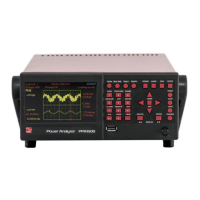PPA5xx/15xx user manual
7-7
7.2.1 Advanced options
Pressing ACQU to access the acquisition control menu then
the R arrow key gives access to some advanced options
which would not be needed for normal measurement
applications.
The analysis for the fundamental component uses a DFT
(discrete Fourier transform) algorithm. The selectivity of
the DFT analysis is a compromise between noise rejection
of frequencies close to the frequency of the fundamental
component and the required stability of the frequency
component. Selecting “narrow” increases the selectivity of
the DFT analysis (reducing the effective bandwidth) which
has the effect of improving the noise rejection. It does,
however, require that the frequency of the fundamental
component is more stable.
In a noisy application, any spikes present on the signal
may push the instrument onto a higher range than is
necessary for the signal being measured. If the nature of
the spurious spikes is such that they do not contribute to
the measurement and can safely be ignored then the
range can be manually set as appropriate for the signal to
be measured and the instrument can be told to ignore any
overload. If using this mode, it is wise to check the signal
on the oscilloscope to be sure that the signal being
measured is not genuinely overrange.
In a very noisy application, where the frequency of the
signal is known but the PPA5xx/15xx is unable to measure
the frequency even with low frequency mode filters
applied, it is possible to enter the frequency to be used for
analysis. When ‘frequency lock’ is selected to be ‘on’ the
present measured frequency is displayed but this can be
overwritten with the known frequency. This entered
frequency is then used for all the analysis and the
frequency of the input signal is not measured.

